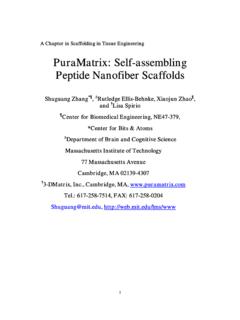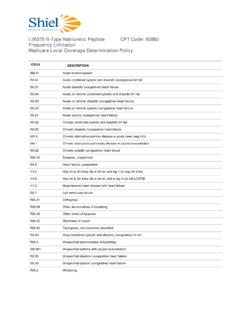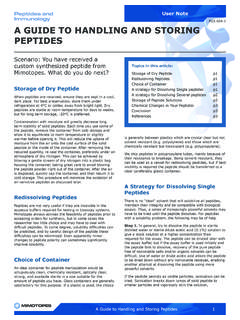Transcription of LTX-315, a first in class oncolytic peptide reshapes the ...
1 BackgroundLTX-315 is a first in class oncolytic peptide with unique release and reshape properties(1,2)Pre-clinical studies of LTX-315 demonstrate: Unique immunogenic cell death mode of action by targeting the mitochondria(3,4) Disintegration of cytoplasmic organelles resulting in effective release of chemokines, danger signals and a broad repertoire of tumor antigens(3-6) Reduced number of immunesuppressive cells(7) Enhanced infiltration of T cells and T cell clonality Complete regression of injected and non-injected tumors ( Abscopal effect)(8,9)
2 A Phase I clinical trial was initiated to evaluate the potential benefit of the oncolytic peptide LTX-315 as a novel intralesional therapeutic aim of this study is to evaluate the safety and tolerability of intra-tumoural LTX-315 monotherapy and determine the recommended phase II dose and Biopharma AS | Gaustadall en 21, NO-0349 Oslo, Norway | E-mail: | Phone: +47 77 67 55 00 | Fax: +47 77 67 55 01 LTX-315, a first in class oncolytic peptide reshapes the tumor microenvironment in the majority of patients with advanced metastatic tumors: Results from an ongoing clinical phase I study YSTEIN REKDAL1, JEAN-FRANCOIS BAURAIN2, AHMED AWADA3, PAAL F.
3 BRUNSVIG4, REBECCA SOPHIE KRISTELEIT5, DAG ERIK J SSANG6, NINA LOUISE JEBSEN7, AURELIEN MARABELLE8, DELPHINE LOIRAT9, JEROME GALON10, FABIENNE HERMITTE11, ANDREW SAUNDERS1, BALDUR SVEINBJ RNSSON1, BERIT NICOLAISEN1, VIBEKE SUNDVOLD GJERSTAD1, JAMES SPICER121 LYTIX BIOPHARMA, NORWAY, 2 CLINICQUE UNIVERSIT , UCL, ST. LUC, BELGIUM, 3 INSTITUT JULES BORDET, UNIVERSIT LIBRE DE BRUXELLES, BELGIUM, 4 OSLO UNIVERSITY HOSPITAL, NORWAY, 5 UNIVERSITY COLLEGE LONDON HOSPITAL, UK, 6 HAUKELAND UNIVERSITY HOSPITAL, NORWAY, 7 CENTRE FOR CANCER BIOMARKERS (CCBIO)
4 UNIVERSITY OF BERGEN, 8 INSTITUT GUSTAVE ROUSSY, PARIS, FRANCE, 9 INSTITUT CURIE, PARIS, 10 FRANCE LABORATORY OF INTEGRATIVE CANCER IMMUNOLOGY, INSERM, PARIS, FRANCE, 11 HALIODX, MARSEILLE, FRANCE, 12 KINGS COLLEGE, GUY S HOSPITAL, UKLTX-315 s Release and Reshape MoAStudy DesignLTX-315 safety (n=28)Immune related response (irRC) assessmentEffect of LTX-315 on key genes involved in immune-mediated tumor regression0816243240 Duration of LTX-315 Treatment (weeks)MELANOMABREASTSARCOMAHEAD AND NECKOTHERirSDirPDDuration of LTX-315 treatmentvPrimary EndpointsSecondary Endpoints Safety (including DLTs, AEs, SAEs, lab assessments) of LTX-315 Inflammatory markers in injected tumor tissue, such as tumor infiltrating lymphocytes Doses of between 2-7mg per injection have been evaluated.
5 No MTD was observed LTX-315-related adverse events (any grade) have been observed in 21 of 28 patients who received > 1 LTX-315 injection 7 of 28 patients (25%) had CTC AE > grade 3 related AEs including allergic reaction/anaphylaxis (4), pain on injection (2) and sepsis (1) 3 of 4 episodes of > grade 3 LTX-315 related allergic reaction/anaphylaxis occurred; 3 occurred after > 10 weeks of treatment; one was a DLT and occurred in week 2 Post-treatment samples (7 in red) are well separated from pre-treatment samples (7 in blue) Out of 7 pairs.
6 5 tumor pairs change from cold (gene expression in blue) to hot (in red) 1 tumor pair with CD8+ T cell infiltration at baseline was turned more hot post treatment 1 tumor pair with no effectHierarchical Clustering of Immunosign 21 Immune Gene Signature (HalioDx) which profiles expressions of a pre-defined set of effector T cell, Th1, chemokine, and cytokine genesStable disease ((SD) median duration 11 weeks) by irRC was observed in 8 of 15 evaluable patients (53%).
7 Local effects of LTX-315 by assessment of: - Necrosis in index lesions determined by ultrasound and resection/biopsy Systemic immunological response with LTX-315 in peripheral blood Anti-tumor activity of LTX-315 by CT scan assessment (immune-related response criteria (irRC))Conclusion LTX-315 is generally safe and tolerable, the majority of toxicities are transient grade 1 2, and include hypotension (asymptomatic) flushing, paresthesia and rash No MTD has been reached Regression in injected and non-injected lesions observed.
8 - Stable disease ((SD) median duration 11 weeks) by irRC was observed in 8 of 15 evaluable patients (53%) - Abscopal effect observed Elevation of tumor infiltrating lymphocytes in injected lesions was observed in 15 of 17 (88%) evaluable patients The HalioDx Immune Gene Expression Signature, Immunosign 21 analysis of LTX-315 treated tumors shows: - Clear effect on key genes (effector T cell, Th1 orientation, chemokines and cytokines)
9 Involved in immune-mediated tumor regression - LTX-315 converts cold tumors to hot, as evident by immune phenotyping using gene expression analysis Results support the rationale and potential benefit of LTX-315 as a novel intratumoral immunotherapy Combination testing of LTX-315 with immune checkpoint inhibitors is ongoing in melanoma and breast cancerReferences1. Haug, et al; J. Med. Chem. (2016)2. Sveinbj rnsson, B. et al.; Future Medicinal Chemistry (2017)3. Zhou, H.
10 Et al.; Oncotarget (2015)4. Eike, L-M. et al.; Oncotarget (2015)5. Forveille, S. et al.; Cell Cycle (2015)6. Zhou, H. et al.; Cell Death Disease (2016)7. Yamazaki, T. et al.; Cell Death and Differentiation (2016)8. Camilio et al.; Cancer Immunol Immunother. (2014)9. Nestvold, J. et al. Onco Immunology (2017)Safety Summary LTX-315 converts cold tumors to hot Biopsies of injected tumors taken at baseline and after treatment have been obtained in 19 patients. All biopsies were taken in up to 3 planes of orientation.







